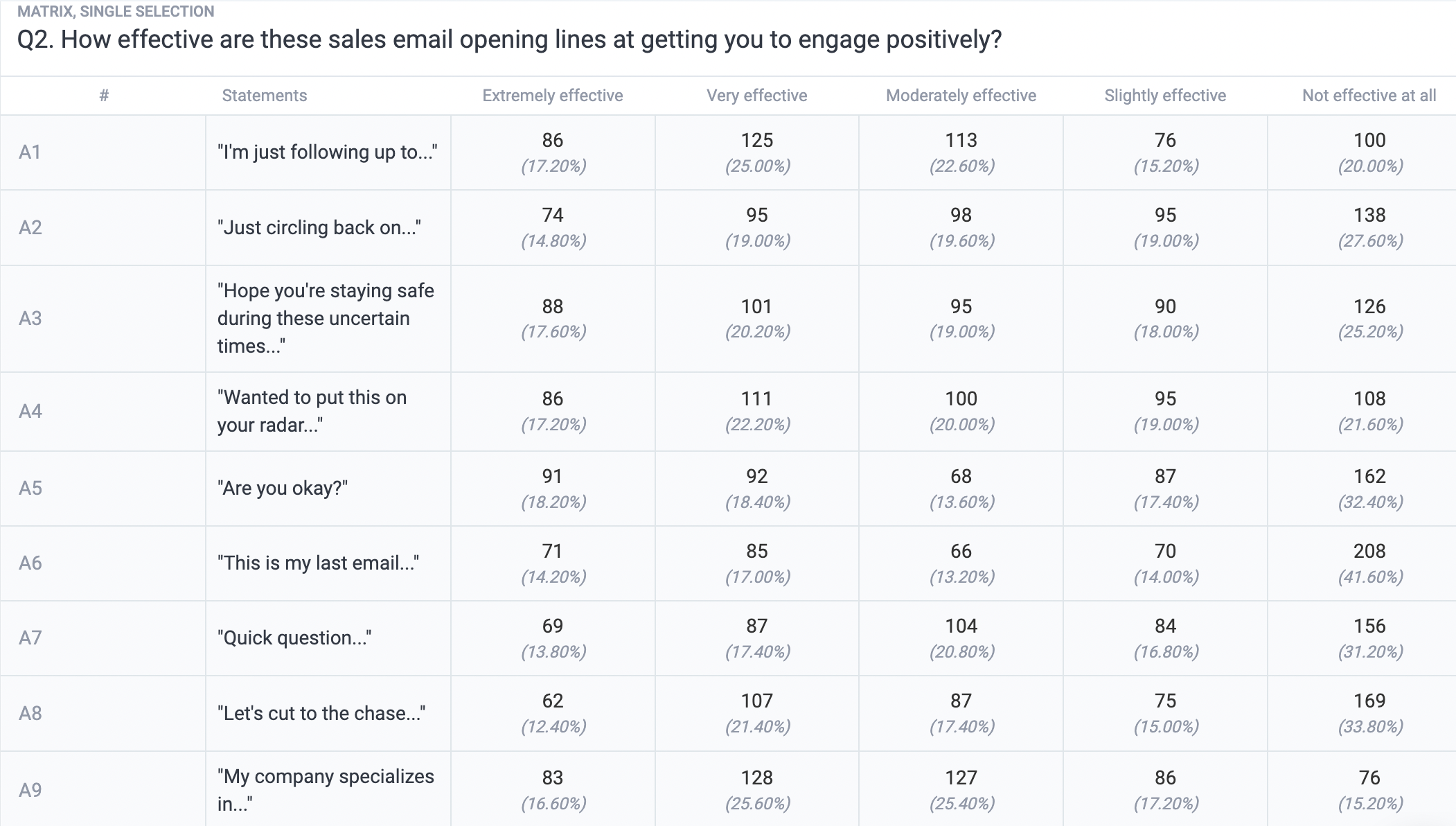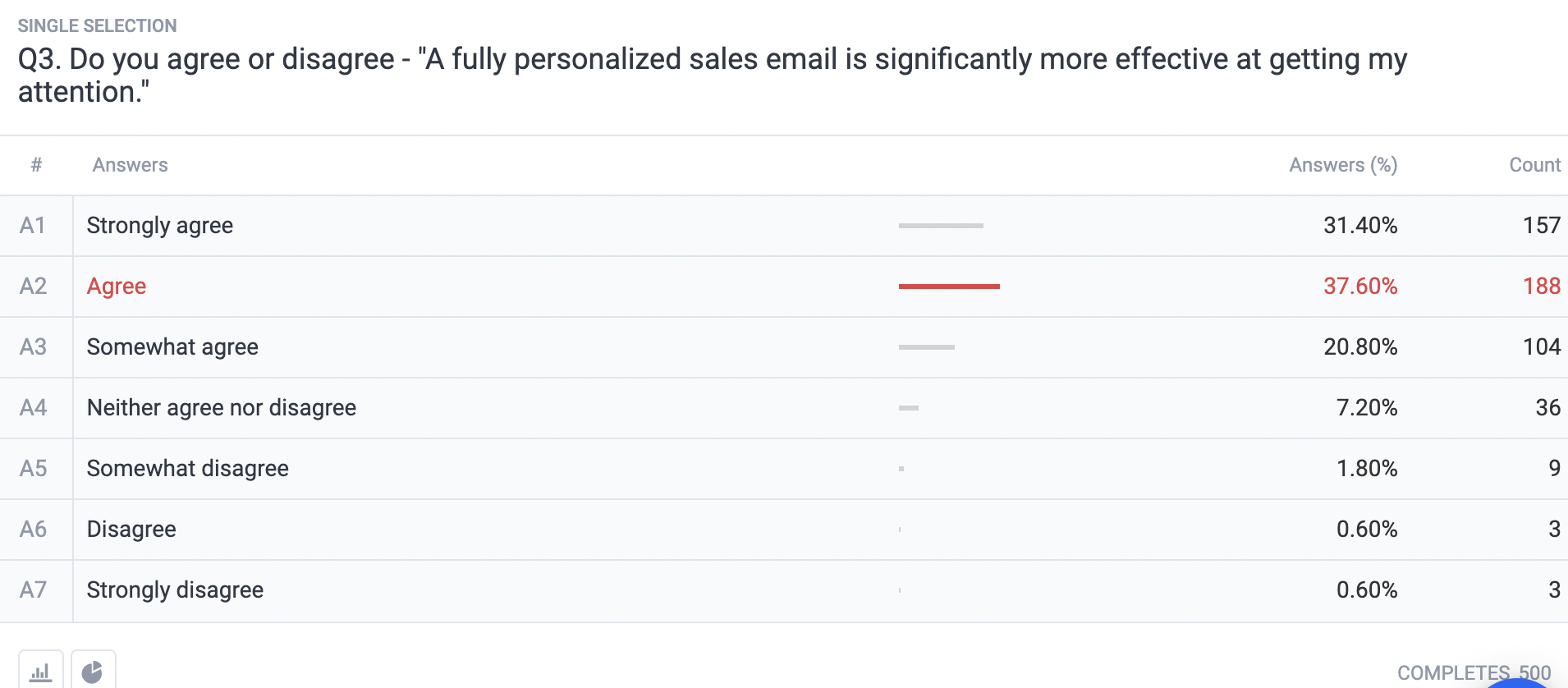B2B Sales Emails: Are they Effective or a Nuisance?
Are B2B sales emails a thorn in your side? Do they drive you crazy?
Virtually all white-collar workers find themselves on the receiving end of these sales emails, from cold pitches to those in the mid-stage of nurturing.
And it’s no wonder why. 33% of marketers send emails weekly and 26% send them various times each month.
But while they tend to be persistent and ongoing, are they any effective?
We surveyed 500 employees of various backgrounds in the US, Canada, UK and Australia to learn how receptive (or not) they are to various B2B sales emails.
Ultimately, our survey begs the question: are sales emails effective or a nuisance to all involved?
1. 44% of employees report receiving sales emails often
First, we asked our respondents (60% in-office workers, 40% remote workers) the most basic question regarding B2B sales emails.
Do salespeople email them trying to sell something to their company?
The results: pretty much everyone gets them and no one (0% — you read that correctly) is immune.
43.6% of employees say they often get emails that solicit them to buy something for their company.
That’s almost half of all business workers contending with sales emails regularly.
What’s more, is that 20.8% say they get these emails constantly.
 35.6% say they sometimes receive these emails.
35.6% say they sometimes receive these emails.
In total, 100% of white-collar workers — the whole lot — receive sales emails.
New to a company? Don’t worry, they’ll come for you next.
All businesses should therefore study their target market to see if their own sales emails bug them or galvanize them to buy.
2. 24% of white-collar employees get 11-15 sales emails per day
Next, we dug into the quantity of sales emails our employee respondents get daily.
Our results prove that the modern-day office employee is bombarded with sales emails.
That’s because the most popular answer at 24% said they get a whopping 11-15 sales emails just in one day.
22.8% report getting a hefty 6-10 emails a day and 22.6% say they get 1-5.
Did you know that some workers are sent even more emails daily?
17% say they get over 20 a day.
Businesses are jockeying for the attention of other businesses via B2B sales emails.
But is this onslaught of emails worth it?
3. Don’t tell employees it’s your last email but you may or may not want to cut to the chase
Moving along, we presented our respondents with a list of email opening statements in a Matrix table, asking them to rate how effective each statement was in getting them to positively engage.
The results are mixed.

Let’s look at the popular answers on both sides on the scale of extremely effective-not effective at all.
Ineffective sales email openers:
- The most popular answer (41.6%) says the “this is my last email” opener is not effective at all.
- 33.8% say “Let’s cut to the chase” is not effective at all.
- 32.4% say “Are you okay?” is not effective at all.
- 31.2% say “Quick question” is not effective at all.
These point to the fact that many sales email recipients hate when they feel their time is wasted with cliched and overused filler phrases.
So be more original and avoid them! If you want to cut to the chase, do so, don’t say you will!
Effective sales email openers:
- The most popular answer (25.6%) says the “my company specializes in” opening line is very effective.
- 25% say “I’m just following up” is very effective.
- 22.2% say “wanted to put this on your radar” is very effective.
- 21.4% say “let’s cut to the chase” is very effective.
Some of these contradict the most popular answers in the ineffective side of the Matrix table. This shows, that while a large portion of employees hate trite phrases, a significant portion is drawn to them.
So how do you know which your leads will positively or negatively respond to?
By studying your prospects and leads via market research. B2B surveys are specifically designed to study businesses and other noncustomer entities (partners, vendors, etc.)
4. 2/3 buy products/services due to cold sales emails
Next, we wanted to gauge exactly how effective sales emails are, specifically cold emails.
It is these sales emails that tend to be challenging, as they come seemingly out of the blue.
Thus, we asked the following:
How often do cold sales emails lead you to buy a specific product or service per year?
Almost one-third (29.2%) say cold emails make them buy 2-5 per year.
20.2% report buying about once a year. 18.6% say maybe once ever.
10.4% estimate buying about 6-10 times a year. 6.8% say more than ten times per year.
Alternatively, 14.8% say cold emails never affect them to buy what said emails are selling.

While these numbers seem scattered and insignificant, they point to a key narrative: no matter how many times businesses buy due to cold emails, they do so overwhelmingly more than they don’t.
That’s because, in total, 66.6% (⅔) of white-collar employees do buy at least something from cold emails, whereas only 14.8% don’t.
The takeaway is that despite seeming to be random and out of the blue, cold emails are effective. Almost all businesses buy something at least once from cold emails.
Thus, you should always leverage the cold email sales tactic, as it has a proven return on investment.
5. Almost 90% of business employees believe a fully personalized sales email is the most effective
Marketing personalization is a hot buzzword that has entered the realm of sales emails.
But do business employees care whether you’re sending them personalized emails or not?
We asked via a Likert scale, about the extent to which respondents agree or disagree with the following: “A fully personalized sales email is significantly more effective at getting my attention.”
It’s a landslide win for those who agree, as they total to a massive 89.8%.
 Those who neither agree nor disagree come out to 7.2%.
Those who neither agree nor disagree come out to 7.2%.
Those who disagree with the effectiveness of personalization add up to only 3% — a drop in the bucket!
As a business, you should opt to have sales (and marketing) employees compose fully personalized sales emails.
That means going beyond just knowing your recipients’ names and companies.
Get insights from 250,000,000+ respondents.
Conduct your own market research for the most effective campaigns, by giving Pollfish a try!
This online survey platform is super user-friendly and offers 24/7 live tech support no matter where you are in the world.
It is incredibly easy to use, as you can make your own survey in just three easy steps.
A DIY survey platform, Pollfish gives you full control of your survey campaign. This includes targeting, questionnaire setup, deployment and your post-survey data.
Leveraging organic sampling and Random Device Engagement, the Pollfish platform provides random organic sampling to users across the globe in their natural online environments, staving off survey bias and providing the highest quality of survey data.
Get started today, research anything now!
Do you want to distribute your survey? Pollfish offers you access to millions of targeted consumers to get survey responses from $1 per complete. Launch your survey today.
Global GSK Shingles Survey Insights
Original Insights,The Pollfish Blog
February 24, 2024
Shingles misconceptions: new global survey commissioned and funded by GSK highlights widespread…
The business/customer disconnect: 82.4% don’t confidently know their pain points 😧
Original Insights,The Pollfish Blog
August 9, 2022
Customer-centric… Buzzword or core model? For great brands, it rings true, but what about for the…
